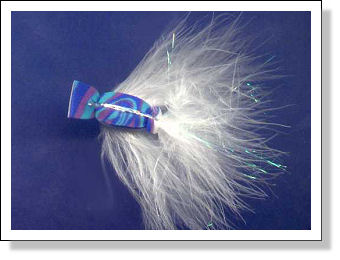
It's autumn once again. The days are getting shorter, the water cooler, and the stripers are becoming more active, chowing down on baitfish and other tasties to fatten themselves up for their journey to their warmer winter homes. In northeastern waters, one of the more common baitfish is the baby bunker (menhaden) which often appear in unusually large schools up and down the coast. These small menhaden will vary in length (most often between 2"-4") and are avidly fed upon by stripers and other game fish.
Two of my favorite flies to fish when the stripers are feeding on baby bunker are the Soft Hackle Baby Bunker and the Baby Bunker Gurgler. The Soft Hackle Baby Bunker seems to work best when the fish are taking the natural baitfish just below the surface or deeper; the Baby Bunker Gurgler comes into its own when the fish are working the surface and busting bait or when the commotion caused by the lip will attract the fish up to the surface.
The Baby Bunker Gurgler is quite simple to tie (and you can make your own variations or substitutions here if you don't have precisely the prescribed materials). It's tied combining several techniques used in other flies described here on the web site, combining the Double-Gurgler style of shell construction with the hackling technique used in the Soft Hackle Streamer as well as the dub-and-pick-out body technique of any of the "Secret" Flies.
Tying Steps
| Hook: |
Daiichi 2546 or Mustad 34007, # 1, # 2 |
| Thread: |
Danville's Flat Waxed Nylon or similar |
| Shell: |
Any closed-cell foam of approximately 1/8" thick. You may use either a single foam of this width or, as I do here, two layers--of different colors--which add up to approx. 1/8" thick. (The colors I use for this fly are made up of a layer of bluish-purple multi-colored foam affixed to a layer of white sticky-back foam but you may substitute plain blue or even plain white for this fly. Since this is a surface fly, it's little likely that the fish are overly concerned with a color they are unlikely to see.) Note: The foam may be cut so that the body and lip are approximately the same size (wide or narrow) or--as done here--cut in what I call a "Tomahawk" style--with a rather narrow tapered shell with a wider lip section. All shapes are useful as long as the foam floats the hook and the lip causes a "gurgle"--I personally tie my Gurglers in a wide variety of configurations (just for the fun of it) and I encourage you to play around with different shapes to achieve different effects. |
| Shell Guard: |
Strands of Pearl Flashabou pulled tightly over shell. Since this step is taken mainly to snug down and secure more tightly the shell to the body and also to protect the shell from the ravages of toothy fish, you may even use--as I sometimes do--a length of 6-10 pound monofilament to achieve this purpose. (This is also a good way to use up some old leader material.) |
| Body: |
Dubbed on and picked out Gartside's Secret Stuff (GSS) (you may substitute any similar material; e.g. Angel hair or such). |
| Hackle: |
Two marabou feathers (each approx. 2" wide at tie-in point). |
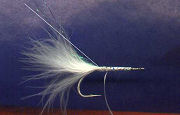 Cover shank with windings of thread. Tie in marabou tail and an overlay of pearl GSS (Gartside's Secret Stuff) or Flashabou. Tie in 5-6 strands of 6" Flashabou or a strand of monofilament at base of tail.
Cover shank with windings of thread. Tie in marabou tail and an overlay of pearl GSS (Gartside's Secret Stuff) or Flashabou. Tie in 5-6 strands of 6" Flashabou or a strand of monofilament at base of tail.
 Tie in foam at base of tail.
Tie in foam at base of tail.
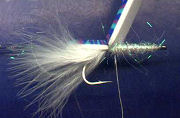 With a bodkin, pick out from all sides of the body as many strands as you need to give body and movement to your imitation. To create a fuller interior body, "rake" body material close to and along the shank, to loosen up the shorter strands.
With a bodkin, pick out from all sides of the body as many strands as you need to give body and movement to your imitation. To create a fuller interior body, "rake" body material close to and along the shank, to loosen up the shorter strands.
 Tie in one marabou hackle feather at base of shell and trim excess. Dub a larger amount of GSS onto thread and wind forward (covering approx. half the shank). Wind marabou hackle feather forward with evenly spaced turns until you use it up. Tie feather off and trim excess.
Tie in one marabou hackle feather at base of shell and trim excess. Dub a larger amount of GSS onto thread and wind forward (covering approx. half the shank). Wind marabou hackle feather forward with evenly spaced turns until you use it up. Tie feather off and trim excess.
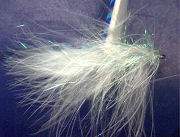 Tie in another marabou hackle feather and trim excess. Dub another quantity of GSS onto thread and wind forward to eye of hook. Wind hackle forward to eye, tie down, and trim excess.
Tie in another marabou hackle feather and trim excess. Dub another quantity of GSS onto thread and wind forward to eye of hook. Wind hackle forward to eye, tie down, and trim excess.
With a bodkin or needle, pick out some longer GSS strands between hackle windings and comb both hackle and GSS so that hackle has a little sparkle blended into it.
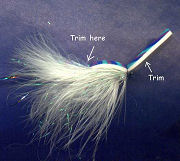 Pull foam tightly over body and tie down just behind eye of hook.
Pull foam tightly over body and tie down just behind eye of hook.
Cut rear portion of foam close to base and pull Flashabou or monofilament tightly forward over shell and tie down. Trim excess. Trim Gurgler lip to desired height (approx. 1/3 to 1/2") and shape (Note: the Gurgler lip may be trimmed flat across or with rounded edges.
At times there are so many baitfish present that feeding fish will not be especially interested in a single-fly offering (they're too taken up with grabbing mouthfuls of bait). When this is the case, I'll often fish a two-fly set-up, tying a Soft Hackle Baby Bunker (with about a 7" separation) to the bend of the Gurgler, a tactic that will often dramatically increase the interest of the fish. You might want to consider this strategy when fishing






